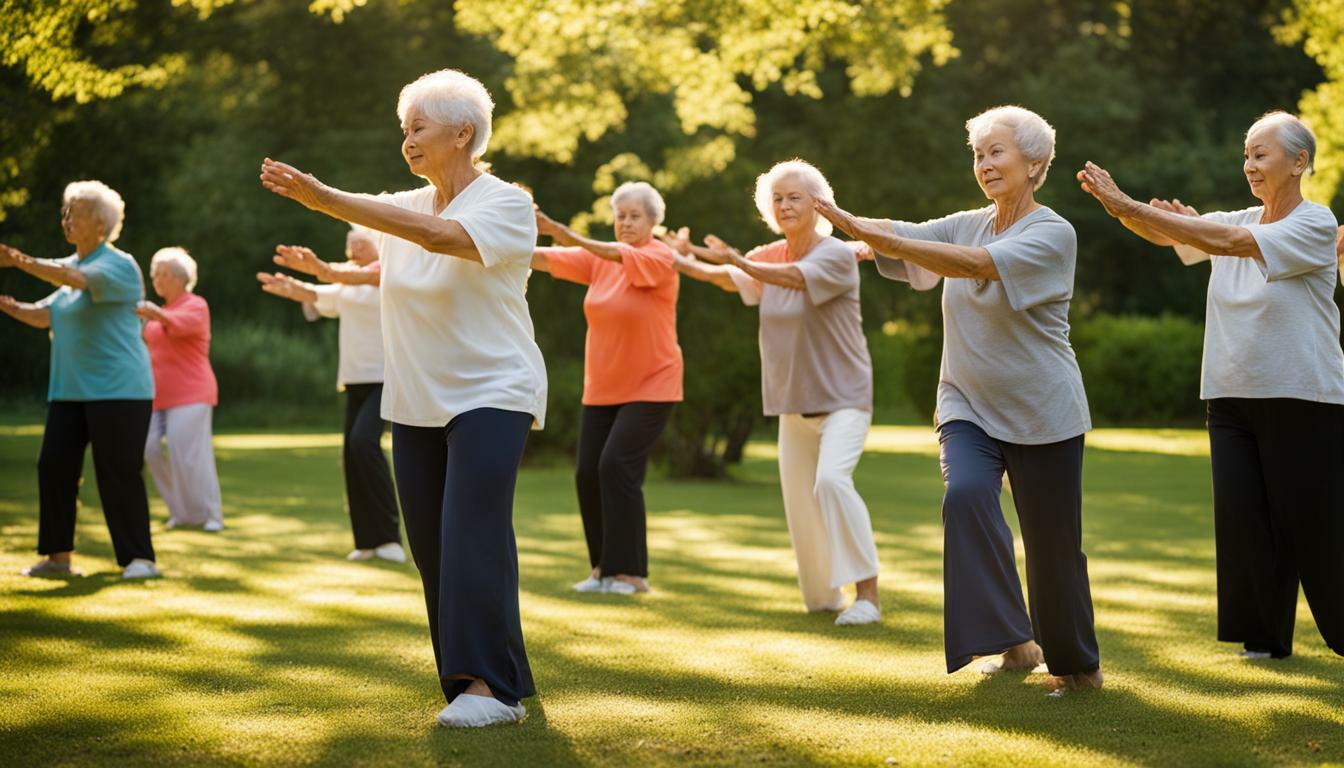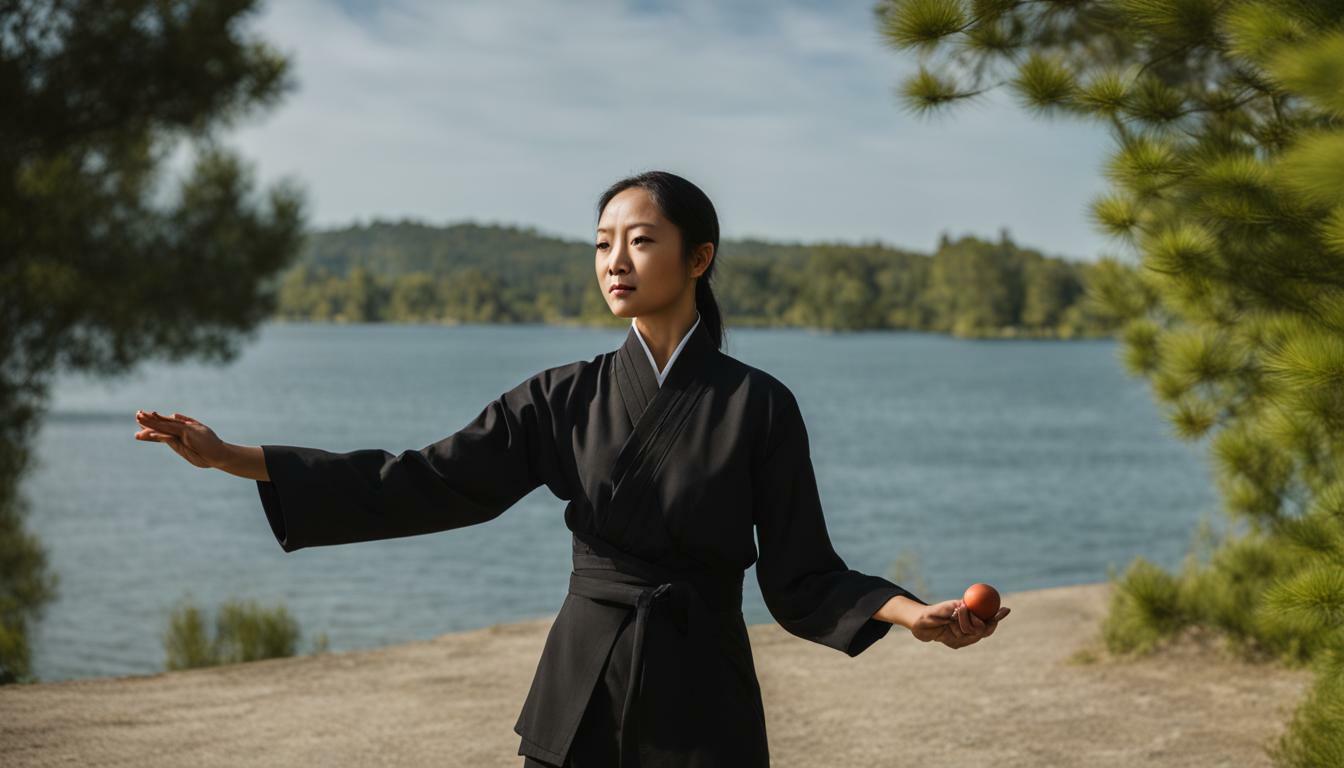
Welcome to our exploration of the power of Tai Chi for Balance. In this section, we will delve into the techniques that can enhance stability and improve coordination. Tai Chi is an ancient Chinese movement practice that focuses on muscle control, stability, balance, and flexibility. Research shows that practicing Tai Chi regularly can improve balance, stability, and flexibility in older people, including those with Parkinson’s disease. It can also help reduce pain, reduce the fear of falling, and improve mood and quality of life for older adults.
Some Tai Chi techniques for stability include leg warm-ups, torso twists, energy to the sky, drawing the bow, and penetrating heaven and earth. Balance training through Tai Chi can be beneficial for people of all ages and can help improve everyday activities, brain health, and overall well-being. Engaging in regular physical activity and adopting simple habits can also contribute to better balance and stability.
Key Takeaways:
- Tai Chi is an ancient Chinese movement practice that improves balance, stability, and flexibility.
- Regular practice of Tai Chi can reduce pain and the fear of falling, and improve mood and quality of life.
- Specific Tai Chi techniques like leg warm-ups and torso twists can enhance stability and coordination.
- Balance training through Tai Chi can benefit people of all ages, improving everyday activities and overall well-being.
- Incorporating regular physical activity and adopting simple habits can also contribute to better balance and stability.
Tai Chi: A Time-Honored Practice for Better Balance
Tai Chi, a time-honored practice rooted in ancient wisdom, offers a multitude of exercises and movements specifically designed to improve balance and strengthen the body. This gentle and flowing martial art has been practiced for centuries in China and has gained popularity worldwide for its numerous health benefits. Whether you’re a young adult, a senior, or anywhere in between, incorporating Tai Chi into your routine can help you achieve better balance and enhance your overall well-being.
With Tai Chi, the focus is not just on physical movements but also on mental concentration and deep breathing. This holistic approach promotes body awareness, control, and stability. Research has shown that regular Tai Chi practice can improve balance, stability, and flexibility, especially in older adults. It can also help reduce pain, decrease the fear of falling, and improve mood and quality of life.
Within Tai Chi, there are specific techniques that target balance and strength. Leg warm-ups, torso twists, energy to the sky, drawing the bow, and penetrating heaven and earth are just a few examples of movements that can enhance stability. These exercises not only challenge your balance but also engage your core muscles, improve coordination, and increase body awareness. By consistently practicing these techniques, you can develop the foundation for better balance in your daily life.
| Benefits of Tai Chi for Better Balance |
|---|
| Improves stability and coordination |
| Reduces the risk of falls |
| Enhances flexibility and strength |
| Promotes body awareness and control |
| Boosts mood and overall well-being |
The Power of Tai Chi for Balance and Strength
Tai Chi’s gentle and deliberate movements, combined with deep breathing and mental focus, create a powerful practice for improving balance and strength. The harmonious flow of Tai Chi can help develop a strong foundation, both physically and mentally, which translates into better stability and overall well-being. So, why not give Tai Chi a try and experience the transformative benefits for yourself?
Tai Chi Techniques for Enhancing Stability
Discover Tai Chi techniques that are specifically designed to enhance stability and improve coordination. Tai Chi is a centuries-old Chinese movement practice that focuses on muscle control, balance, and flexibility. Regular practice of Tai Chi has been shown to improve balance and stability in people of all ages, including older adults and individuals with conditions such as Parkinson’s disease.
One technique that can enhance stability is leg warm-ups. These exercises involve gentle movements that target the legs and help improve strength and balance. By gradually warming up the legs and engaging the muscles, you can enhance stability and reduce the risk of falls. Incorporating leg warm-ups into your Tai Chi routine can provide a solid foundation for better balance and coordination.
Another technique is torso twists, which focus on the rotation of the upper body. These movements help strengthen the core muscles and improve balance and stability. By incorporating torso twists into your Tai Chi practice, you can develop increased coordination and a stronger sense of balance. This can translate into improved stability in everyday activities, such as walking and turning.
Table: Tai Chi Techniques for Enhancing Stability
| Technique | Description | Benefits |
|---|---|---|
| Leg Warm-ups | Gentle leg movements to improve strength and balance | Enhances stability, reduces risk of falls |
| Torso Twists | Rotations of the upper body to strengthen core muscles | Improves balance and coordination |
In addition to leg warm-ups and torso twists, other Tai Chi techniques that can enhance stability include “energy to the sky,” “drawing the bow,” and “penetrating heaven and earth.” These movements focus on controlled weight shifting, alignment, and flowing transitions, all of which contribute to improved balance and coordination.
Remember, balance training through Tai Chi can be beneficial for people of all ages. By incorporating these techniques into your regular practice, you can enhance stability, improve coordination, and experience the many other benefits that Tai Chi has to offer, including improved brain health and overall well-being.
Tai Chi for Falls Prevention and Everyday Activities
Discover how practicing Tai Chi can help prevent falls and enhance your performance in everyday activities. Tai Chi is an ancient Chinese movement practice that focuses on muscle control, stability, balance, and flexibility. Research has shown that regular practice of Tai Chi can improve balance, stability, and flexibility in older people, including those with Parkinson’s disease.
According to a study published in the New England Journal of Medicine, Tai Chi reduced the risk of falls by 58% in older individuals. The slow and controlled movements of Tai Chi help improve muscle strength, coordination, and balance, making it an effective technique for falls prevention.
By incorporating Tai Chi into your daily routine, you can build strength, improve posture, and increase body awareness, all of which contribute to better balance and stability. It can also help reduce pain, alleviate symptoms of anxiety and depression, and improve mood and quality of life for older adults.
Tai Chi Techniques for Stability
Including specific Tai Chi techniques in your practice can further enhance stability. Some recommended techniques include:
- Leg warm-ups: These exercises focus on strengthening the lower body, improving balance, and increasing stability.
- Torso twists: These movements help improve flexibility in the spine and enhance core strength, aiding in stability and balance.
- Energy to the sky: This technique involves extending the arms upward while focusing on maintaining proper alignment and balance.
- Drawing the bow: This movement helps improve leg strength and stability, as well as opening the chest and improving posture.
- Penetrating heaven and earth: This technique involves shifting weight between the legs, improving balance, and enhancing stability.
By incorporating these techniques into your Tai Chi practice, you can experience increased stability, improved coordination, and enhanced overall balance.
| Tai Chi Benefits for Falls Prevention and Everyday Activities |
|---|
| Reduces the risk of falls by improving balance and coordination |
| Enhances muscle strength and flexibility, improving performance in daily tasks |
| Reduces pain and improves overall well-being |
| Aids in symptom management for conditions such as Parkinson’s disease |
| Increases body awareness and improves posture |
Balance training through Tai Chi can be beneficial for people of all ages. Engaging in regular physical activity, adopting simple habits, and incorporating Tai Chi into your routine can contribute to better balance, stability, and overall well-being. So why not start practicing Tai Chi today and experience the transformative effects it can have on your life?
Additional Tips for Better Balance
Here are some additional tips and insights to help you achieve better balance and stability in your daily life. Incorporating these habits and practices into your routine can have a significant impact on your overall well-being.
First, engage in regular physical activity. Exercise is essential for maintaining balance and stability. Try incorporating activities that focus on strength, flexibility, and coordination, such as Tai Chi. Tai Chi is a gentle form of exercise that emphasizes controlled movements and weight shifting, making it perfect for improving balance.
Next, adopt simple habits that promote balance. Pay attention to your posture throughout the day, making sure to stand tall with your shoulders back and your core engaged. Take breaks from sitting and move around to keep your body active. These small adjustments can go a long way in improving your overall balance.
Lastly, consider incorporating Tai Chi into your routine. Tai Chi has been shown to enhance stability and coordination, making it an effective technique for improving balance. By practicing Tai Chi regularly, you can improve your muscle control, flexibility, and overall well-being. Start with simple movements and gradually increase the intensity as you progress.
Remember, balance training through Tai Chi can be beneficial for people of all ages. Whether you are looking to prevent falls, improve your everyday activities, or enhance your brain health, Tai Chi can be a valuable addition to your fitness routine. So, why not give it a try and experience the benefits of better balance and stability in your life?
FAQ
What is Tai Chi?
Tai Chi is an ancient Chinese movement practice that focuses on muscle control, stability, balance, and flexibility.
What are the benefits of practicing Tai Chi for balance?
Research shows that practicing Tai Chi regularly can improve balance, stability, and flexibility in older people, including those with Parkinson’s disease. It can also help reduce pain, reduce the fear of falling, and improve mood and quality of life for older adults.
What are some Tai Chi techniques for stability?
Some Tai Chi techniques for stability include leg warm-ups, torso twists, energy to the sky, drawing the bow, and penetrating heaven and earth.
Can Tai Chi help improve balance for people of all ages?
Yes, balance training through Tai Chi can be beneficial for people of all ages and can help improve everyday activities, brain health, and overall well-being.
What are some additional tips for better balance?
Engaging in regular physical activity and adopting simple habits can also contribute to better balance and stability. Incorporating Tai Chi into your routine can further enhance balance and stability, positively impacting brain health and overall well-being.



